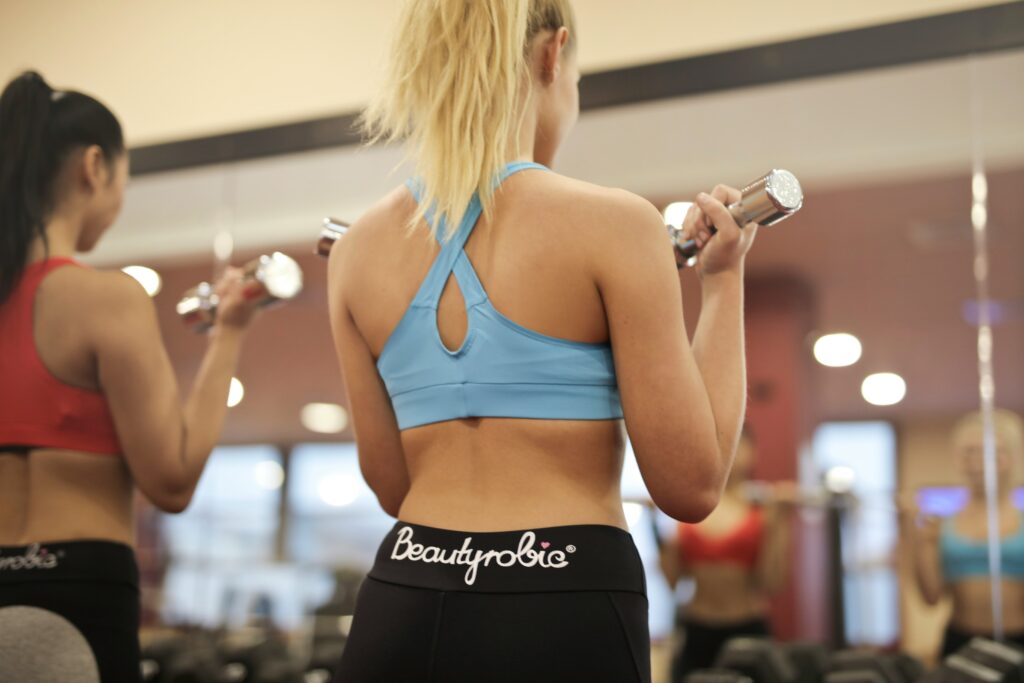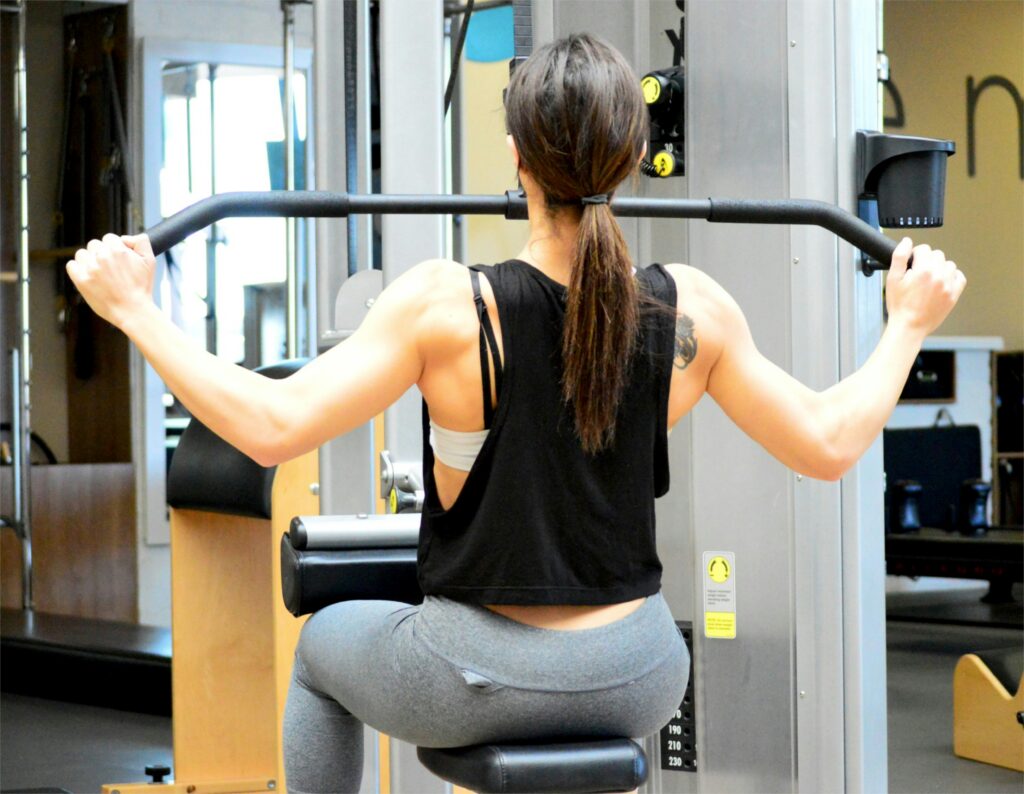New to weights? Every question you’ve ever had about strength training answered
April 12, 2024

It’s not so very long ago that weights were only something big burly men did. The message was loud and clear: strength training isn’t for girls. Women were consigned to cardio workouts, and not much else.
But revolution is afoot, and I for one am pleased to see it. In the past few years, strength training has exploded, and people are finally realising that lifting weights is beneficial for everyone, not just the muscular men you see in the gym.
Unlike hopping on a treadmill or pushing yourself on the spin bike though, weight training, if you’re new to it, can seem a little intimidating.
And if you don’t know your sets from your reps or you’ve found yourself asking ‘What the hell is progressive overload?’ you probably aren’t alone.
Let me reassure you that weight training isn’t nearly as complicated or as daunting as you think it is, and once you know what’s what, you can reap the many, many rewards of lifting weights, from improved metabolism and mental health to increased strength, mobility, and more.
Got questions? Let me (a fully qualified PT who creates strength-based workouts for busy mums) answer them for you…

I love cardio. Should I incorporate strength-training as well?
My mantra when it comes to exercise is ‘You do you!’. When you find something you love, you’re more likely to stick with it, so if you enjoy it, keep up the cardio.
That said, strength training has SO many benefits (I wrote about just a few of them here) and is an excellent long-term health and wellbeing strategy, so it’s a good idea to incorporate it into your schedule if you can.
Strength training is functional (In other words, it helps you more easily complete tasks in your daily life) it will keep you fit, active, and mobile in old age, and it’s a healthy and sustainable way to manage your weight.
A win-win, wouldn’t you say?
Two words to become familiar with before you start your strength training journey: reps (i.e. repetitions) and sets.
Reps are the action of one complete exercise (for example, a tricep dip), while sets are how many times you will repeat a particular number of reps of the given exercise, in a row between rest periods.
How heavy should I lift?
My advice? Don’t underestimate yourself. Ask yourself this: how often do you pick your little one up off the floor or walk around with them perched on your hip? That’s several kilos you’re lifting right there – so remind yourself of this when reaching for a dumbbell.
Figuring out how heavy to lift often takes a little bit of trial and error. A good rule of thumb to follow? If you can do 12 reps easily then your weight is too light. If you really struggle to hit six reps, then chances are it’s too heavy.
You want the last 2-3 reps to be challenging to complete but not too hard that you lose correct form.

Should I keep a record of my strength workouts?
Yep, it’s a good idea to do this, noting how many reps and sets you completed and the weight you used.
This will allow you to track progression, be time efficient, ensure you aren’t lifting weight under your potential and, if you apply progressive overload (more on that to come…), you will physically see yourself getting fitter and stronger.
Everyone’s talking about progressive overload. What is it?
You’ve probably heard the phrase ‘What doesn’t challenge you, doesn’t change you.’ That’s basically what progressive overload is in a nutshell. It’s about consistently increasing the weight you’re lifting or the number of reps you complete.
This challenges the body, placing the muscles under greater stress and allowing them to grow over time.
Wondering how to get started? It’s a good idea to make a note of what weight you’re lifting on each exercise and then aim to either increase it or add on more reps when your strength improves and you feel you have more to give.
You can also increase the tempo. For example, if you want to progress your squat, you could slow the movement down, lowering for a count of three seconds and then rising up for a count of one.
The sense of accomplishment you get when you see yourself improving is next level!

Should I always rep to failure?
‘Failure’ is a word that often has negative connotations but don’t let that put you off. Where weight training is concerned, it can actually be a good thing.
It simply means pushing yourself to your absolute limit, so that on your last rep you ‘fail’ or almost fail. It’s the physical equivalent of giving 100%.
Do you need to rep to failure to make progress? Most of the research suggests that leaving roughly 1-3 reps in the tank during each set is the best way to maximise your gains.
But a word of caution. Pushing yourself shouldn’t come at the expense of correct form, not least because it can increase your risk of injury. Feel free to start out with a heavier weight, and switch it for a lighter one on a later set if your form goes or you’re too fatigued to continue.
And another thing: it’s important to remember that giving 100% will look different on different days. You won’t make PBs every week, but regularly acknowledging that you are stronger than you realise and celebrating that is so rewarding.
Will strength training make me look bulky?
Ah, this old chestnut. Let me shut this argument down once and for all. First things first, building muscle takes a long time, so no, you aren’t going to look like a powerlifter overnight.
Packing on serious muscle involves a lot of very heavy strength workouts and a generous calorie surplus. In short? It takes a lot of effort and intention.
Second, because muscle burns more calories than fat, you’ll actually burn more body fat – and in turn, build more lean muscle mass – in the long run. In other words? It results in a leaner (not bulkier) looking physique.
Add to that, women have less testosterone than men so it’s a lot harder for us to pack on a lot of muscle.
So now you know: When you stick with strength training, you’re more likely to look lean, sculpted, and toned, than you are bulky.

How long does it take to build muscle?
This is one of those ‘How long is a piece of string?’ questions. (Sorry!) But if you’ve been challenging yourself by lifting heavy and upping your protein intake, you can expect to see improvements in strength and muscle tone anywhere from a few weeks to several months.
My advice? Don’t get too caught up in seeing physical changes. We’re often blind to our own progress anyway, and real, sustainable change takes time.
Seeing a bicep peeking through or a little extra definition around your shoulders can be really exciting, but try to focus on how you feel. Relish that delicious feeling of getting stronger and having more energy and improved mental health, it will motivate you to keep going.
Strength training intimidates me. What can I do to get started?
First things first, gym-timidation is a real thing and you aren’t alone in feeling that way. You may have seen strong men and women online pumping iron and thought ‘I could never do that!’.
But everyone has to start somewhere – and I promise you, weightlifting isn’t as scary or intimidating as it seems.
First things first, follow a plan. Knowing what exercises you want to do and watching tutorials on how to perform them correctly can take away a good deal of fear. Next, start with a light weight, and for your first few sessions, focus on perfecting your form.
Another tip? If you’re working out in a public gym, remind yourself that nobody is judging you. I promise you that most people are too in the zone to notice that you’re a newbie.
If getting to a gym is difficult for you – or being honest, just a little bit too scary – then consider a programme like Power Of Mum. This on-demand video programme features strength workouts that are beginner-friendly, effective, and fun.
You can do them at home on your own time and you’ll get stacks of support from me!
So there you have it: a detailed primer on all things weight training. I hope it gives you the confidence to pick up those weights and get moving.
The most important thing is to enjoy it. Celebrate the little wins along the way – the first push up, lifting heavier, or completing more reps.